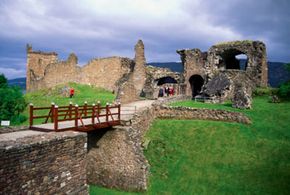History of Castles
Castles evolved from ancient walled cities like Troy, Babylon, Jericho and Mycenae. These cities had thick, high stone walls with gates that limited traffic flow. Soldiers would stand guard at the gates and on the walls to fend off attackers.
The earliest type of castle was essentially a ringed fort called a grod. A grod consisted of wooden and earthen walls (ramparts), a fortified gate or gates and a surrounding moat.
Advertisement
A second type of early castle stemmed from the high, round watchtowers that the Romans built along their frontiers. The tower, called a bergfried, was made of wood (and stone, starting in the 13th century). Bergfrieds, found throughout Germany, were the predecessors of the tall towers in later medieval castles.
The third type was motte and bailey castles. They consisted of a mound (motte), which was located within an open courtyard (bailey) that was enclosed by wooden wall with a fortified gate. On top of the motte was a wooden tower called a donjon. The motte and bailey castle incorporated features of the grod and the bergfried. They became popular during the reign of Charlemagne in France (A.D. 800) and were used widely by William the Conqueror after the Norman conquest of England in 1066. The motte and bailey could be constructed in a matter of weeks or months.
These early castles laid the foundations for developments of castles in the High Middle Ages.
- Stone and brick walls replaced wooden ones. Stone walls were sturdier and could be built much higher.
- In some castles, an inner wall was added, forming a concentric ring. This extra wall provided more defenses.
- The bailey became larger and divided into separate courtyards.
- The donjon became larger and made of stone -- and its name changed to the keep.
- Other buildings were added in the baileys -- like great halls, palaces, chapels, residences for knights and servants, stables and workplaces for craftsmen.
- Several large, tall towers were built into the castle. Some towers were incorporated into the outer walls, while others were freestanding structures within the courtyard.
We'll learn more about these features on the next page.
